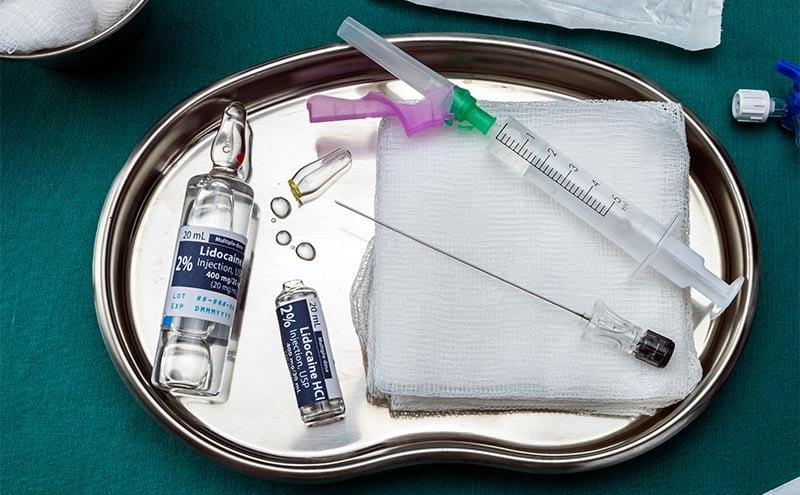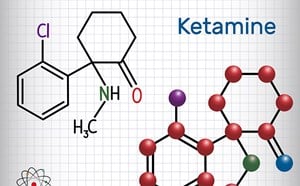
January 14, 2021
More Than a Local Agent: 10 Pearls of IV Lidocaine Use for Pain in the ED
- Lidocaine is an amide-type local anesthetic that exerts its pharmacological action through the blockade of sodium channels in neural tissues, interrupting neuronal transmission. The exact mechanism by which IV lidocaine provides systemic analgesia remains largely unknown.1
- Animal studies with IV lidocaine reveal reduced hyperalgesia and modulation of the inflammatory response. Clinical trials have demonstrated improved pain control in the perioperative setting and in some neuropathic pain syndromes.2
- IV lidocaine has demonstrated efficacy in both central and visceral pain management.3
- Studies demonstrating benefit in renal colic have sparked interest and discussion within the emergency medicine community.4,5 In a 2019 pilot, unblinded RCT, researchers at UC San Francisco found that IV lidocaine provides similar analgesia to IV morphine for undifferentiated severe pain in the ED.6
- The ideal dose of an IV lidocaine bolus for acute pain is not known. Per a 2017 systematic review published in the Annals of Emergency of Medicine, the most common dosing is 1.5 mg/kg.7 One protocol suggested using the patient’s ideal body weight (IBW) if their BMI is > 30.8 There is no agreed upon time of administration, but some feel the bolus should be given over 30 minutes.9,10
- Lidocaine can affect cardiac conduction; obtaining a baseline ECG is recommended by some.11 Telemetry may be used during infusion for arrhythmia monitoring.
- Lidocaine has a very narrow therapeutic index. Less serious adverse effects include nausea, vomiting, dizziness, perioral numbness, dysarthria, slurring of speech, and vertigo. If these occur, the infusion rate should be decreased in half. If symptoms do not resolve after a few minutes, the infusion should be stopped. Potential serious adverse events include seizures, dysrhythmias, hypotension, and cardiac arrest.7
- Modified dosages are indicated in the setting of abnormal acid-base status, hypercapnia or hypoxia, low plasma protein level, and diminished hepatic or renal function.8
- Emergency physicians should be well versed in the management of local anesthetic systemic toxicity (LAST) when administering IV lidocaine. Steps in management include stopping the infusion, managing the patient’s airway, suppressing seizures, managing arrhythmias, administering lipid emulsion (<70 kg - 5 mL/kg IV, followed by infusion at 0.25 mL/kg/minute IV; >70 kg - 100 mL IV, followed by infusion of 200 to 250 mL IV over 15 to 20 minutes), and arranging for cardiopulmonary bypass.12
- Many of the clinical trials with IV lidocaine identified pregnancy as an exclusion criteria.13-15 IV lidocaine and its metabolites cross the placenta. Lidocaine may have adverse reactions in the fetus including CNS, heart, or peripheral vascular tone.16
References
- Friedrichsdorf SJ, Goubert L. Pediatric pain treatment and prevention for hospitalized children. Pain Rep. 2019 Dec 19;5(1):e804. doi: 10.1097/PR9.0000000000000804. PMID: 32072099; PMCID: PMC7004501.
- Van Der Wal SE, Van Den Heuvel SA, Radema SA, et al. The in vitro mechanisms and in vivo efficacy of intravenous lidocaine on the neuroinflammatory response in acute and chronic pain. Eur J Pain. 2016 May;20(5):655-74. doi: 10.1002/ejp.794. Epub 2015 Dec 18. PMID: 26684648.
- Firouzian A, Alipour A, Rashidian Dezfouli H, et al. Does lidocaine as an adjuvant to morphine improve pain relief in patients presenting to the ED with acute renal colic? A double-blind, randomized controlled trial. Am J Emerg Med. 2016 Mar;34(3):443-8. doi: 10.1016/j.ajem.2015.11.062. Epub 2015 Dec 1. PMID: 26704774.
- Milne, Ken. “Is Intravenous Lidocaine for Pain Safe and Effective in the ED?”ACEP Now, 19 Sept. 2018, www.acepnow.com/article/is-intravenous-lidocaine-for-pain-safe-and-effective-in-the-ed/.
- LaPietra, Alexis. “Intravenous Lidocaine for Renal Colic.”ALiEM, 14 Feb. 2018, www.aliem.com/intravenous-lidocaine-for-renal-colic/.
- Clattenburg EJ, Nguyen A, Yoo T, et al. Intravenous lidocaine provides similar analgesia to intravenous morphine for undifferentiated severe pain in the emergency department: A pilot, unblinded randomized controlled trial. Pain Med. 2019 Apr 1;20(4):834-839. doi: 10.1093/pm/pny031. PMID: 29741660.
- E Silva LOJ, Scherber K, Cabrera D, et al. Safety and efficacy of intravenous lidocaine for pain management in the emergency department: A systematic review. Ann Emerg Med. 2018 Aug;72(2):135-144.e3. doi: 10.1016/j.annemergmed.2017.12.014. Epub 2018 Feb 1. PMID: 29395284.
- Eipe N, Gupta S, Penning J. Intravenous lidocaine for acute pain: an evidence-based clinical update,BJA Education, Volume 16, Issue 9, September 2016, Pages 292–298, https://doi.org/10.1093/bjaed/mkw008
- Finnerup NB, Biering-Sørensen F, Johannesen IL, et al. Intravenous lidocaine relieves spinal cord injury pain: a randomized controlled trial. Anesthesiology. 2005 May;102(5):1023-30. doi: 10.1097/00000542-200505000-00023. PMID: 15851891.
- Cahana A, Carota A, Montadon ML, et al. The long-term effect of repeated intravenous lidocaine on central pain and possible correlation in positron emission tomography measurements. Anesth Analg. 2004 Jun;98(6):1581-4, table of contents. doi: 10.1213/01.ane.0000113258.31039.c8. PMID: 15155309.
- Buck, Kara, et al.Systemic Lidocaine for the Treatment of Pain - Adult/Pediatric - Inpatient/Ambulatory/Emergency Department Clinical Practice Guideline. UWHealth, 9 Oct. 2019, www.uwhealth.org/cckm/cpg/medications/Systemic-Lidocaine-for-the-Treatment-of-Pain---Adult-Pediatric---IP-Amb-ED-191003.pdf.
- Warren, Lisa, and Aimee Pak. “Local Anesthetic Systemic Toxicity.”UpToDate, Waltham, MA, 2019.
- Soleimanpour H, Hassanzadeh K, Vaezi H, et al. Effectiveness of intravenous lidocaine versus intravenous morphine for patients with renal colic in the emergency department. BMC Urol. 2012 May 4;12:13. doi: 10.1186/1471-2490-12-13. PMID: 22559856; PMCID: PMC3508963.
- Tanen DA, Shimada M, Danish DC, et al. Intravenous lidocaine for the emergency department treatment of acute radicular low back pain, a randomized controlled trial. J Emerg Med. 2014 Jul;47(1):119-24. doi: 10.1016/j.jemermed.2012.12.014. Epub 2014 Apr 24. PMID: 24768290.
- Vahidi E, Shakoor D, Aghaie Meybodi M, et al. Comparison of intravenous lidocaine versus morphine in alleviating pain in patients with critical limb ischaemia. Emerg Med J. 2015 Jul;32(7):516-9. doi: 10.1136/emermed-2014-203944. Epub 2014 Aug 21. PMID: 25147364.
- “Lidocaine (Systemic): Drug Information.”UpToDate - Lexicomp, Waltham, MA, 2020.
Paul DeJulio, MD
Emergency and Internal Medicine Chief Resident
The Ohio State University Wexner Medical Center
Jessica Oswald, MD, MPH
Assistant Professor Pain Medicine
Assistant Professor Emergency Medicine
Department of Anesthesia
University of California San Diego Health


